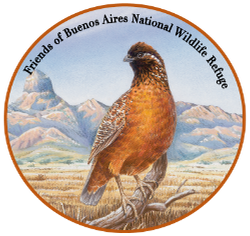The Refuge
Between 1909 and 1985, Buenos Aires Ranch changed ownership several times. It became one of the most prominent and successful livestock operations in Arizona. From 1926 to 1959, the Gill family raised prize-winning racing quarter horses. During the 1970s and 80s, the Victorio Land and Cattle Company specialized in purebred Brangus cattle, which are well suited to hot, dry climates.
On February 20, 1985, the Secretary of the Interior Donald Hodel announced that the U.S. Fish and Wildlife Service would purchase the Buenos Aires Ranch as a national wildlife refuge for the endangered masked bobwhite. At that time, Secretary Hodel expressed the agency’s belief that the Buenos Aires Ranch was the only place in the United States providing suitable habitat for the Masked Bobwhite Quail. Since that time, refuge staff, wildlife biologists, volunteers and many partners have worked together to restore the original landscape of open, semidesert grasslands and bring back the native wildlife that once called these lush prairies home.
An hour southwest of Tucson in the Altar Valley is 118,000 acres of protected and managed Sonoran grasslands. This is the major part of the Buenos Aires National Wildlife Refuge. A few miles east, near the town of Arivaca, is the Arivaca Cienega (wetlands) and Arivaca Creek. This critical riparian corridor is also managed by the Buenos Aires National Wildlife Refuge.
The Baboquivari Mountains which flank the grasslands to the west are the western-most of the sky islands of southeastern Arizona. Deep in the heart of these mountains beneath the tower of Baboquivari Peak is Brown Canyon. Here the Buenos Aires Refuge is charged with protecting and preserving a sky island canyon ecosystem. This is the location of the Environmental Education Center Lodge.
The diversity of wild-lands embraced by these three units of the Buenos Aires Refuge make it a particularly important tract of Sonoran ecosystems. The Refuge Headquarters and Visitor Center are in the old Buenos Aires Ranch buildings and visitor exhibits, information, a bookshop and shady grounds for enjoying the “good airs” and expansive vistas.
